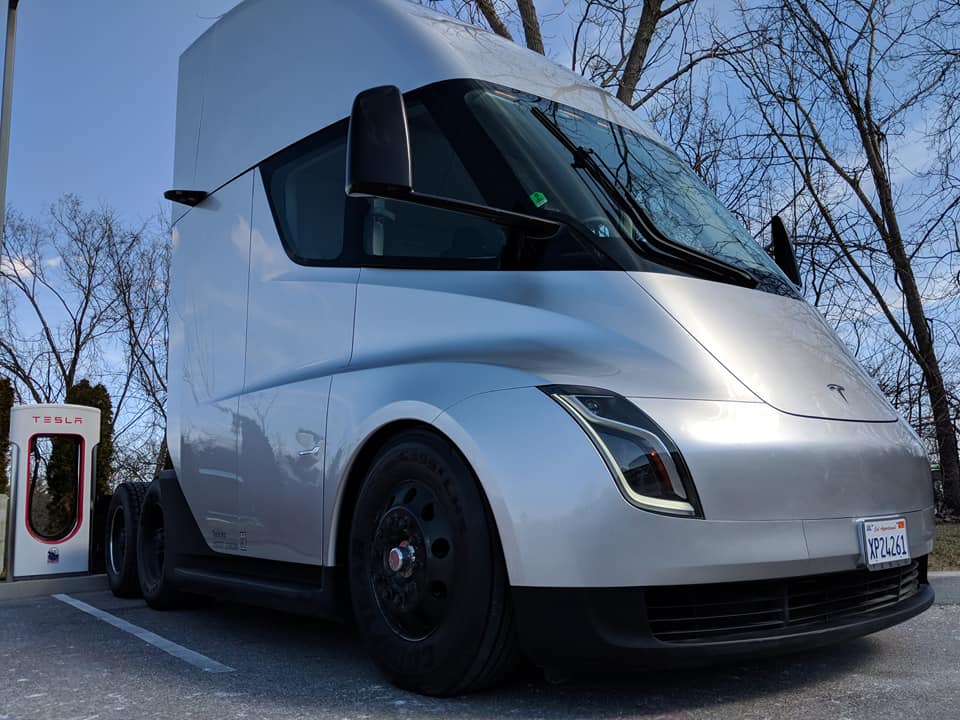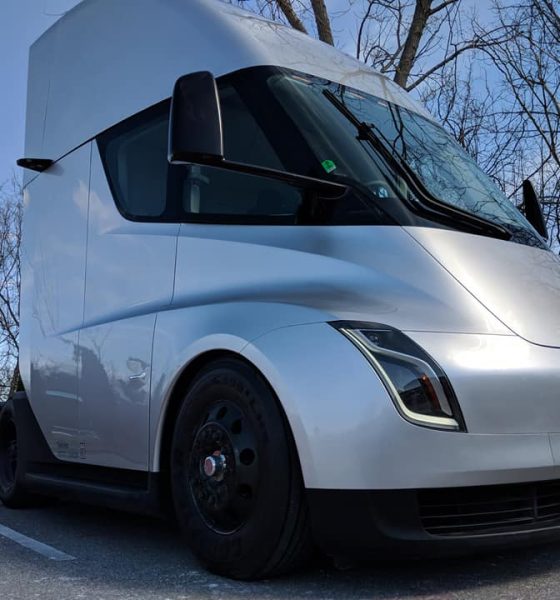

News
FedEx places order for 20 Tesla Semi electric trucks
FedEx Corp. has joined the likes of UPS, PepsiCo, and Anheuser-Busch as the Tesla Semi’s latest customer. In a press release, the American multinational courier delivery services company announced that it had placed a reservation for 20 electric trucks from Tesla, as part of its initiative to push green technologies into its operations.
The press release, which was released Monday morning, noted that the 20 Tesla Semis would be deployed and operated by FedEx Freight, the company’s less-than-truckload (LTL) service, which covers the transportation of relatively small cargo. According to FedEx Freight president and CEO Mike Ducker, the company’s investment and commitment to the Tesla Semi stands as its latest statement on its continuing efforts to incorporate sustainability into its day-to-day systems.
“FedEx has a long history of innovation and incorporating sustainability efforts throughout its global network. Our investment in these trucks is part of our commitment to improving road safety while also reducing our environmental impact,” the FedEx Freight CEO said.
In the company’s press release about the purchase of the Class 8 electric trucks, FedEx asserted that it had been actively engaged in green initiatives for the past decade. According to FedEx, the company has saved approximately 158 million gallons of fuel since 2008, thanks to its adoption of vehicles that employ fuel cells, natural gas, hybrid engines, and electric drivetrains. The company also noted that it is in a continuous process to replace its legacy fleet with more efficient and environmentally friendly vehicles, such as the Tesla Semi.
The Tesla Semi features four Model 3-derived electric motors, making it completely emissions-free. The instant torque provided by its electric motors also enables the long-hauler to pull its load with speeds that are far beyond the industry standard. During its unveiling, Tesla CEO Elon Musk announced that the Semi is capable of going from 0-60 mph while pulling a full 80,000 load in as little as 20 seconds. Without cargo, the electric truck is even faster, showing tire-shredding acceleration, as could be seen in a previous sighting of the vehicle.
Over the past couple of weeks, Tesla appears to be deploying its long-range silver Semi prototype to some of its biggest reservation holders. Two weeks ago, the electric truck was spotted in Anheuser-Busch’s brewery in St. Louis, MO. The truck was parked in the brewery for a few hours, and was later seen parked at a Supercharger in St. Charles, roughly 24 miles away from the Anheuser-Busch facility.
Last week, the Tesla Semi was spotted in a Dallas, TX Service Center, before being sighted at the Reunion Tower the following day, where Tesla and PepsiCo reportedly held a demo for the electric truck. Ryan O’Donnell, a member of the Tesla community who lives in the area, was able to enter the demo event, snapping some close-up pictures of the electric truck. O’Donnell also noted that a PepsiCo employee stated that the company’s 100 orders for the Tesla Semi were just a “drop in the bucket” for how many units the beverage and snack company is planning to order in the future.

News
Tesla starts showing how FSD will change lives in Europe
Local officials tested the system on narrow country roads and were impressed by FSD’s smooth, human-like driving, with some calling the service a game-changer for everyday life in areas that are far from urban centers.

Tesla has launched Europe’s first public shuttle service using Full Self-Driving (Supervised) in the rural Eifelkreis Bitburg-Prüm region of Germany, demonstrating how the technology can restore independence and mobility for people who struggle with limited transport options.
Local officials tested the system on narrow country roads and were impressed by FSD’s smooth, human-like driving, with some calling the service a game-changer for everyday life in areas that are far from urban centers.
Officials see real impact on rural residents
Arzfeld Mayor Johannes Kuhl and District Administrator Andreas Kruppert personally tested the Tesla shuttle service. This allowed them to see just how well FSD navigated winding lanes and rural roads confidently. Kruppert said, “Autonomous driving sounds like science fiction to many, but we simply see here that it works totally well in rural regions too.” Kuhl, for his part, also noted that FSD “feels like a very experienced driver.”
The pilot complements the area’s “Citizen Bus” program, which provides on-demand rides for elderly residents who can no longer drive themselves. Tesla Europe shared a video of a demonstration of the service, highlighting how FSD gives people their freedom back, even in places where public transport is not as prevalent.
What the Ministry for Economic Affairs and Transport says
Rhineland-Palatinate’s Minister Daniela Schmitt supported the project, praising the collaboration that made this “first of its kind in Europe” possible. As per the ministry, the rural rollout for the service shows FSD’s potential beyond major cities, and it delivers tangible benefits like grocery runs, doctor visits, and social connections for isolated residents.
“Reliable and flexible mobility is especially vital in rural areas. With the launch of a shuttle service using self-driving vehicles (FSD supervised) by Tesla in the Eifelkreis Bitburg-Prüm, an innovative pilot project is now getting underway that complements local community bus services. It is the first project of its kind in Europe.
“The result is a real gain for rural mobility: greater accessibility, more flexibility and tangible benefits for everyday life. A strong signal for innovation, cooperation and future-oriented mobility beyond urban centers,” the ministry wrote in a LinkedIn post.
News
Tesla China quietly posts Robotaxi-related job listing
Tesla China is currently seeking a Low Voltage Electrical Engineer to work on circuit board design for the company’s autonomous vehicles.

Tesla has posted a new job listing in Shanghai explicitly tied to its Robotaxi program, fueling speculation that the company is preparing to launch its dedicated autonomous ride-hailing service in China.
As noted in the listing, Tesla China is currently seeking a Low Voltage Electrical Engineer to work on circuit board design for the company’s autonomous vehicles.
Robotaxi-specific role
The listing, which was shared on social media platform X by industry watcher @tslaming, suggested that Tesla China is looking to fill the role urgently. The job listing itself specifically mentions that the person hired for the role will be working on the Low Voltage Hardware team, which would design the circuit boards that would serve as the nervous system of the Robotaxi.
Key tasks for the role, as indicated in the job listing, include collaboration with PCB layout, firmware, mechanical, program management, and validation teams, among other responsibilities. The role is based in Shanghai.
China Robotaxi launch
China represents a massive potential market for robotaxis, with its dense urban centers and supportive policies in select cities. Tesla has limited permission to roll out FSD in the country, though despite this, its vehicles have been hailed as among the best in the market when it comes to autonomous features. So far, at least, it appears that China supports Tesla’s FSD and Robotaxi rollout.
This was hinted at in November, when Tesla brought the Cybercab to the 8th China International Import Expo (CIIE) in Shanghai, marking the first time that the autonomous two-seater was brought to the Asia-Pacific region. The vehicle, despite not having a release date in China, received a significant amount of interest among the event’s attendees.
Elon Musk
Elon Musk and Tesla AI Director share insights after empty driver seat Robotaxi rides
The executives’ unoccupied tests hint at the rapid progress of Tesla’s unsupervised Robotaxi efforts.

Tesla CEO Elon Musk and AI Director Ashok Elluswamy celebrated Christmas Eve by sharing personal experiences with Robotaxi vehicles that had no safety monitor or occupant in the driver’s seat. Musk described the system’s “perfect driving” around Austin, while Elluswamy posted video from the back seat, calling it “an amazing experience.”
The executives’ unoccupied tests hint at the rapid progress of Tesla’s unsupervised Robotaxi efforts.
Elon and Ashok’s firsthand Robotaxi insights
Prior to Musk and the Tesla AI Director’s posts, sightings of unmanned Teslas navigating public roads were widely shared on social media. One such vehicle was spotted in Austin, Texas, which Elon Musk acknowleged by stating that “Testing is underway with no occupants in the car.”
Based on his Christmas Eve post, Musk seemed to have tested an unmanned Tesla himself. “A Tesla with no safety monitor in the car and me sitting in the passenger seat took me all around Austin on Sunday with perfect driving,” Musk wrote in his post.
Elluswamy responded with a 2-minute video showing himself in the rear of an unmanned Tesla. The video featured the vehicle’s empty front seats, as well as its smooth handling through real-world traffic. He captioned his video with the words, “It’s an amazing experience!”
Towards Unsupervised operations
During an xAI Hackathon earlier this month, Elon Musk mentioned that Tesla owed be removing Safety Monitors from its Robotaxis in Austin in just three weeks. “Unsupervised is pretty much solved at this point. So there will be Tesla Robotaxis operating in Austin with no one in them. Not even anyone in the passenger seat in about three weeks,” he said. Musk echoed similar estimates at the 2025 Annual Shareholder Meeting and the Q3 2025 earnings call.
Considering the insights that were posted Musk and Elluswamy, it does appear that Tesla is working hard towards operating its Robotaxis with no safety monitors. This is quite impressive considering that the service was launched just earlier this year.








